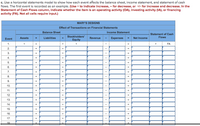
FINANCIAL ACCOUNTING
10th Edition
ISBN: 9781259964947
Author: Libby
Publisher: MCG
expand_more
expand_more
format_list_bulleted
Question
Practice Help, please.

Transcribed Image Text:The following accounting events apply to Mary's Designs for Year 1:
**Asset Source Transactions**
1. Began operations by acquiring $16,000 of cash from the issue of common stock.
2. Performed services and collected cash of $900.
3. Collected $4,900 of cash in advance for services to be provided over the next 12 months.
4. Provided $12,200 of services on account.
5. Purchased supplies of $470 on account.
**Asset Exchange Transactions**
6. Purchased $4,200 of land for cash.
7. Collected $7,100 of cash from accounts receivable.
8. Purchased $420 of supplies with cash.
9. Paid $3,700 for one year’s rent in advance.
**Asset Use Transactions**
10. Paid $2,800 cash for salaries of employees.
11. Paid a cash dividend of $1,900 to the stockholders.
12. Paid off $470 of the accounts payable with cash.
**Claims Exchange Transactions**
13. Placed an advertisement in the local newspaper for $150 on account.
14. Incurred utility expense of $115 on account.
**Adjusting Entries**
15. Recognized $3,675 of revenue for performing services. The collection of cash for these services occurred in a prior transaction. (See Event 3.)
16. Recorded $1,480 of accrued salary expense at the end of Year 1.
17. Recorded supplies expense. Had $90 of supplies on hand at the end of the accounting period.
18. Recognized three months of expired prepaid rent that had been used up during the accounting period.

Transcribed Image Text:c. Use a horizontal statements model to show how each event affects the balance sheet, income statement, and statement of cash flows. The first event is recorded as an example. (Use + to indicate increase, - for decrease, or +/- for increase and decrease. In the Statement of Cash Flows column, indicate whether the item is an operating activity (OA), investing activity (IA), or financing activity (FA). Not all cells require input.)
MARY'S DESIGNS
**Effect of Transactions on Financial Statements**
| Event | Assets | = | Liabilities | + | Stockholders' Equity | Revenue | - | Expenses | = | Net Income | Statement of Cash Flows |
|-------|--------|---|-------------|---|---------------------|---------|---|----------|---|------------|------------------------|
| 1 | + | = | | + | | | - | | = | | + FA |
| 2 | | = | | | | | | | = | | |
| 3 | | = | | | | | | | = | | |
| 4 | | = | | | | | | | = | | |
| 5 | | = | | | | | | | = | | |
| 6 | | = | | | | | | | = | | |
| 7 | | = | | | | | | | = | | |
| 8 | | = | | | | | | | = | | |
| 9 | | = | | | | | | | = | | |
| 10 | | = | | | | | | | = | | |
| 11 | | = | | | | | | | = | | |
| 12 | | = | | | | | | | = | | |
| 13 | | =
Expert Solution
This question has been solved!
Explore an expertly crafted, step-by-step solution for a thorough understanding of key concepts.
This is a popular solution
Trending nowThis is a popular solution!
Step by stepSolved in 2 steps with 1 images

Knowledge Booster
Learn more about
Need a deep-dive on the concept behind this application? Look no further. Learn more about this topic, accounting and related others by exploring similar questions and additional content below.Similar questions
arrow_back_ios
SEE MORE QUESTIONS
arrow_forward_ios
Recommended textbooks for you

 AccountingAccountingISBN:9781337272094Author:WARREN, Carl S., Reeve, James M., Duchac, Jonathan E.Publisher:Cengage Learning,
AccountingAccountingISBN:9781337272094Author:WARREN, Carl S., Reeve, James M., Duchac, Jonathan E.Publisher:Cengage Learning, Accounting Information SystemsAccountingISBN:9781337619202Author:Hall, James A.Publisher:Cengage Learning,
Accounting Information SystemsAccountingISBN:9781337619202Author:Hall, James A.Publisher:Cengage Learning, Horngren's Cost Accounting: A Managerial Emphasis...AccountingISBN:9780134475585Author:Srikant M. Datar, Madhav V. RajanPublisher:PEARSON
Horngren's Cost Accounting: A Managerial Emphasis...AccountingISBN:9780134475585Author:Srikant M. Datar, Madhav V. RajanPublisher:PEARSON Intermediate AccountingAccountingISBN:9781259722660Author:J. David Spiceland, Mark W. Nelson, Wayne M ThomasPublisher:McGraw-Hill Education
Intermediate AccountingAccountingISBN:9781259722660Author:J. David Spiceland, Mark W. Nelson, Wayne M ThomasPublisher:McGraw-Hill Education Financial and Managerial AccountingAccountingISBN:9781259726705Author:John J Wild, Ken W. Shaw, Barbara Chiappetta Fundamental Accounting PrinciplesPublisher:McGraw-Hill Education
Financial and Managerial AccountingAccountingISBN:9781259726705Author:John J Wild, Ken W. Shaw, Barbara Chiappetta Fundamental Accounting PrinciplesPublisher:McGraw-Hill Education


Accounting
Accounting
ISBN:9781337272094
Author:WARREN, Carl S., Reeve, James M., Duchac, Jonathan E.
Publisher:Cengage Learning,

Accounting Information Systems
Accounting
ISBN:9781337619202
Author:Hall, James A.
Publisher:Cengage Learning,

Horngren's Cost Accounting: A Managerial Emphasis...
Accounting
ISBN:9780134475585
Author:Srikant M. Datar, Madhav V. Rajan
Publisher:PEARSON

Intermediate Accounting
Accounting
ISBN:9781259722660
Author:J. David Spiceland, Mark W. Nelson, Wayne M Thomas
Publisher:McGraw-Hill Education

Financial and Managerial Accounting
Accounting
ISBN:9781259726705
Author:John J Wild, Ken W. Shaw, Barbara Chiappetta Fundamental Accounting Principles
Publisher:McGraw-Hill Education